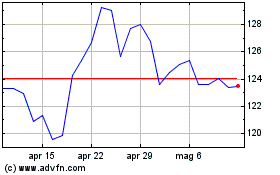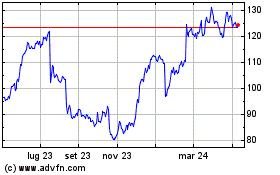Visa's New Tune on Card Signatures: Don't Sign on the Dotted Line
12 Gennaio 2018 - 6:29PM
Dow Jones News
By AnnaMaria Andriotis
Visa Inc. is ditching the signature.
The largest U.S. card network announced Friday that merchants,
starting in April, will no longer be required to make consumers
sign for debit and credit-card purchases, signaling the demise of a
procedure that was once a linchpin of keeping transactions
secure.
The other major U.S. networks, Mastercard Inc., American Express
Co. and Discover Financial Services, in recent months said they
would take the same step. The signature will still be used by
merchants who choose to keep it and, in Visa's case, will still be
required at merchants that don't accept the security chips that are
installed in newer cards.
The companies say improved security features, in particular the
chips that in recent years have been embedded in most Americans'
debit and credit cards, outweigh the security provided by
signatures. Some say a written name scrawled on a slip of paper or
electronic pad fails to provide much protection these days.
Removing the signature will also speed up in-store checkout for
many consumers, they add.
Many consumers have caught on -- signing their name with speed
rather than with legibility in mind. The increasing number of card
transactions in recent years has basically made something that
seemed official more mundane.
Some consider it more of a frill and long ago stopped taking it
seriously. Colby Gergen, a 28-year old software product manager in
Phoenix, says he signs almost every credit card receipt using two
triangles. At times, he has used a smiley face.
Mr. Gergen used to sign his full name, then switched to signing
only C and G until his signature began to look like two halves of a
triangle. One day about three years ago, he figured he'd draw two
triangles on a card receipt and see if any store would reject
it.
No one did. The new approach is "a combination of speed,
laziness and knowing the signature didn't really matter," Mr.
Gergen says.
Others are showing off on social media more creative signatures
they've offered to merchants, including stick figures, whale
drawings and phone numbers asking cashiers or waiters to call
them.
Sadie Morrison, co-owner of Portland, Ore.-based Peruvian
restaurant Las Primas, takes screenshots of some of the more
interesting signage that customers leave on their receipts. Among
her favorites: A signature that consisted of two stars, two swirly
circles and a stick-figure face with a unibrow and earrings.
Another one read: "You're my favorite Las Primas!"
Some merchants say consumers who play around with their
signatures aren't the ones who are likely trying to pay with a
stolen credit card. "Someone paying with a stolen credit card isn't
likely to spend a lot of time drawing attention to themselves," Ms.
Morrison said.
As more commerce has migrated online and to mobile phones,
signatures have been replaced by passwords, fingerprint recognition
and other biometrics. Many gas stations require entering a ZIP Code
instead of a signature when paying with a credit card.
In many countries outside the U.S., debate about signatures long
ago became anachronistic. In most of Europe, consumers have used
chip credit cards for decades and have had to validate a
transaction using a personal identification number, or PIN. The
method has also been adopted in Australia and Canada.
In the U.S., chip cards came into mainstream use in 2015. But
the credit cards didn't feature the PIN as some card companies
feared this would slow transactions. Signatures were largely left
in place instead of instituting PINs.
Card companies say that chip cards have helped to reduce fraud
and that new measures under way, including biometric identification
like fingerprints and facial recognition, will provide additional
security in the future.
Visa, which processed $836 billion in U.S. transactions in the
third quarter, is requiring chip-cards for the signature change in
part to incentivize more merchants to accept chip cards. Card
companies say that some types of fraud have declined due to chip
cards, because chip transactions generate a unique one-time code
that is needed for the transaction to be approved -- a feature that
is very difficult to replicate in a counterfeit card. But some
merchants have stuck to accepting the magnetic strips on cards that
consumers swipe in part due to the costs of installing the
technology to accept the new cards.
Card networks have required signatures for decades, though
changes implemented over the years loosened that requirement
depending on the dollar amount of the transaction. Roughly 75% of
Visa U.S.-based debit and credit card transactions currently don't
require a signature because they are below certain dollar
amounts.
Even so, the fact that signatures have held on for some long
amazes some. When Mastercard in October said it was ditching
signatures, a consumer wrote on its message board: "Congrats on
catching up with the rest of the world, America. About time."
Write to AnnaMaria Andriotis at annamaria.andriotis@wsj.com
(END) Dow Jones Newswires
January 12, 2018 12:14 ET (17:14 GMT)
Copyright (c) 2018 Dow Jones & Company, Inc.
Grafico Azioni Discover Financial Servi... (NYSE:DFS)
Storico
Da Giu 2024 a Lug 2024

Grafico Azioni Discover Financial Servi... (NYSE:DFS)
Storico
Da Lug 2023 a Lug 2024
